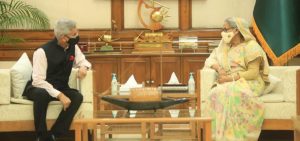During his visit to Dhaka on April 28, India’s Minister for External Affairs S. Jaishankar met with Bangladeshi Prime Minister Sheikh Hasina as well as Foreign Minister Abdul Momen. While the declared purpose of Jaishankar’s visit was to hand over in person a letter from Indian Prime Minister Narendra Modi to Hasina, inviting her to visit India, regional geopolitics was no doubt an important item on the Indian foreign minister’s agenda in Dhaka.
“India’s geopolitical interest underlies Jaishankar’s visit to Bangladesh,” a leading Bangladeshi journalist who reports on foreign affairs told The Diplomat.
Jaishankar’s visit to Bangladesh came close on the heels of his recent visits to Maldives and Sri Lanka and a day ahead of his visit to Bhutan. His swing through South Asia seems aimed at building India’s geopolitical influence in the region.
The Indian foreign minister “has been visiting neighboring countries to stop China’s growing influence in the region,” the journalist added.
Regarding his Bangladesh visit, Jaishankar said that “India looks forward to a stronger sub-regional cooperation in connectivity and other areas. We hope to see early commissioning now of many projects including in power and energy sector, in connectivity so that all that we have done in the last few years can be taken forward.”
An important development emerged out of the meetings. Hasina is reported to have told Jaishankar that India’s northeastern states could use Bangladesh’s Chittagong port.
Partition of the Indian subcontinent left India’s Northeast without direct access to the sea. Still, the region was able to access ports in erstwhile East Pakistan till the 1965 war. In the decades since, the states of Northeast India have used an overland route via the narrow Siliguri Corridor to Kolkata Port.
The route from the Northeast to Chittagong port is shorter than the route to Kolkata port. The distance from Agartala in the state of Tripura to Kolkata port is about 1,600 km while to Chittagong it is just 450 km. Transport of cargo to Chittagong port will therefore take less time and cost less as well.
Not surprisingly then, for decades, India has been looking to increase connectivity with Bangladesh especially for access to its Chittagong port. India’s relentless efforts to get such access resulted in Bangladesh signing a Memorandum of Understanding in 2015 and eventually a treaty in 2018. However, apart from conducting a trial run there has been no progress in this regard.
During Jaishankar’s visit, Hasina appears to have agreed to take this connectivity to Chittagong port forward.
Bangladesh’s location in the Bay of Bengal, which is the northern extension of the strategically important Indian Ocean, has made Bangladesh the focus of several global and regional powers including the U.S., China, Japan, and India. China’s trillion-dollar Belt and Road Initiative and especially the maritime component of this initiative has resulted in Beijing’s influence growing in several Indian Ocean countries including Bangladesh. India, Japan, and the U.S. are building their presence in Bangladesh too through their involvement in various infrastructure projects.
To contain China’s rising belligerence in the Indo-Pacific region, the U.S., Australia, Japan, and India have come together in the Quad. In the context of China’s rising presence in Bangladesh, India and the U.S. have been pressing Dhaka to join the Quad.
During his visit to Dhaka in 2020, U.S. Deputy Secretary of State Stephen E. Biegun invited Bangladesh to join the Quad. “The U.S. sees Bangladesh as a key partner in the Indo-Pacific region … we are committed to growing our partnership in this regard to advance a free and open Indo-Pacific. Bangladesh will be the centerpiece of our work in the region,” he said.
China has warned Bangladesh against joining the Quad. “Bangladesh’s relations with China will substantially be damaged if it does so,” Chinese Ambassador to Bangladesh Li Jiming said in May 2021.
So far Bangladesh has been silent on the question of joining the Quad.
In February this year, Momen drew attention to rising Chinese investment in Bangladesh. China is not only offering Bangladesh a “basket of money” but also it has come forward with “aggressive and affordable” proposals to meet Bangladesh’s infrastructure needs, even as investment from other countries was “declining,” he said.
Bangladesh’s silence on the Quad and the huge Chinese investment in Bangladesh are of concern for India.
Meanwhile, Bangladesh is looking to India to settle the dispute over the sharing of the waters of the Teesta River . With India not releasing enough water of the Teesta to Bangladesh the northern parts of the country are dry, impacting agriculture in the region.
In addition, Bangladesh is concerned over the U.S. sanctions on Bangladesh’s Rapid Action Battalion (RAB) over the latter’s alleged violation of human rights. It is seeking India’s help to get the U.S. to lift these sanctions.
Both India and Bangladesh have their concerns and interests and are looking to each other for understanding and support. Both have leverage too.
India and Bangladesh are locked in a dispute over the Teesta River and the two countries have not been able to resolve the conflict over the last 50 years. While India is the Teesta’s upper riparian country, Bangladesh has been able to get China to invest around a billion dollars in a project on this river.
Will Chinese investment in the Teesta project push India to reach a settlement with Bangladesh?
Jaishankar’s visit was no doubt driven by geopolitical interests. An opportunity has opened up for Bangladesh to bargain hard with India. Will Bangladesh succeed? That will become known when Hasina visits India in a few months.

































